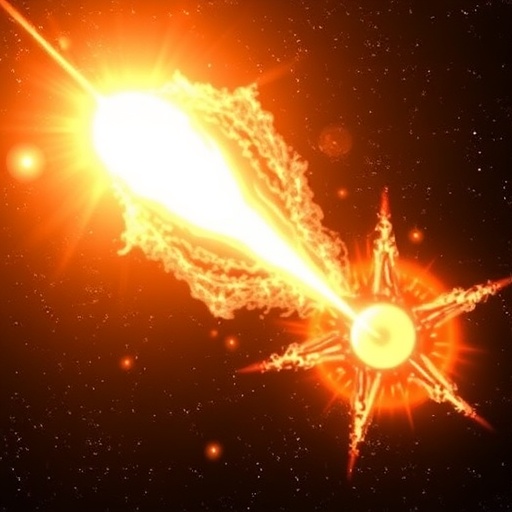Astronomers have recently made a groundbreaking discovery revealing the intricate dynamics of young star systems. An explosion in space, propelled by a baby star, has demonstrated a complex feedback mechanism that may fundamentally alter our understanding of stellar formation. This dramatic event showcases the dynamic, often violent processes that characterize the early stages of star and planet formation, highlighting that the environments surrounding young stars may be much harsher than previously conceived.
The genesis of stars and their planetary systems typically begins with the gravitational collapse of enormous molecular clouds within galaxies. As these clouds collapse under their own gravity, they undergo a fascinating transformation, retaining their angular momentum. This leads to the formation of a spinning disk of material, known scientifically as a protoplanetary disk, where stars and planets begin to coalesce. Interestingly, not all of the matter within these disks is consumed in the creation of stellar bodies; instead, significant quantities are expelled in powerful jets directed along the disk’s rotational axis. These jets serve a vital role in regulating the disk’s material, effectively shedding excess angular momentum and assisting in the orderly formation of celestial entities.
A significant advancement came when a team of astronomers from Japan conducted a meticulous reevaluation of archival data concerning protoplanetary disks collected by the Atacama Large Millimeter/submillimeter Array (ALMA). During their analysis, researchers stumbled upon an unexpected and explosive phenomenon: a bubble structure that appeared to be expanding rapidly near the protoplanetary disk labeled WSB 52. Located approximately 441.3 light-years from Earth in the Ophiuchus constellation, this protoplanetary disk has now taken center stage in a new paradigm of star formation dynamics.
Detailed observations revealed something unprecedented; a shock front produced by this expanding bubble was colliding with the protoplanetary disk, causing significant distortion. While astronomers have documented similar expanding bubble structures around other young stars, it’s the collision event with the surrounding disk that sets this observation apart. This interaction was unexpected and not previously predicted by theoretical models, indicating a gap in the scientific community’s understanding of star-forming environments.
Further examination uncovered a striking correlation: the center of the expanding bubble was aligned precisely with the rotational axis of the protoplanetary disk. Statistically, such an alignment occurring by pure chance is nearly impossible. This compelling alignment suggests a more profound interrelation between the baby star and the energetic jets emanating from it. The research team posited that a fast-moving jet produced by WSB 52 thousands of years ago collided with nearby cold gas, which precipitated a violent reaction. This collision compressed the gas, leading to a spike in pressure that ultimately caused an explosive event, resulting in the observable expanding bubble.
Leading the research, Masataka Aizawa of Ibaraki University elucidated the staggering complexity of these natural phenomena. He drew an analogy to science fiction, where devices unleash destructive energy, resulting in explosions that send debris flying back at the source of the attack. He noted that while this imaginative depiction exists in fictional narratives, real astronomical processes manifest similar, albeit more intense, dynamics. Aizawa expressed a desire to delve deeper into the implications of these discoveries, particularly the effects of these violent interactions on the overall formation of stars and their accompanying planetary systems.
This research broadens our comprehension of the sometimes violent and tumultuous environments in which galaxies evolve, underscoring that star formation is far from a serene process. Instead, it is a series of highly dynamic interactions, both contributing to and counteracting the processes that give rise to stars and planets. Understanding these processes will have profound implications, not just for the formation of individual star systems, but for our broader understanding of galaxy formation and evolution.
Moreover, the findings suggest that the infant stages of stars and their potential planetary systems could be subject to extreme conditions not previously appreciated. Such insights highlight the necessity for ongoing observational campaigns employing advanced technologies like ALMA, which provide astronomers with unprecedented views of these astrophysical phenomena. As our observational capabilities continue to improve, so too will our understanding of the intricate tapestry of cosmic evolution.
Going forward, the implications of this discovery will be significant as researchers begin to consider how these feedback mechanisms might influence not just the birth of stars, but the evolution of entire galaxies. Future studies will undoubtedly seek to explore similar explosive events across a wider range of celestial phenomena, potentially revolutionizing our understanding of star and planet formation. The complexities of these interactions reveal the richness of astrophysical processes and signal an exciting era of research into the cosmos.
The exploration of young stars like WSB 52 promises to shed light on the myriad interactions affecting star formation. As researchers continue to investigate the multifaceted relationships between jets, bubbles, and disks, we might unearth insights that could redefine our understanding of the lifecycle of stars and planets. Each new discovery serves as a stepping stone towards a fuller understanding of the cosmos, illustrating how each element within it is interconnected, influencing one another in a delicate dance governed by the laws of physics.
In conclusion, the recent findings regarding the jet-bubble-disk interaction around protoplanetary disks present a captivating narrative that underscores the complexity of star formation within the universe. This discovery not only challenges existing theories but opens new avenues for inquiry that could significantly enrich our understanding of the birth and evolution of stars and their associated planetary systems.
Subject of Research: Jet-bubble-disk interaction in protoplanetary disk WSB 52
Article Title: Discovery of Jet-Bubble-Disk Interaction: Jet Feedback on a Protoplanetary Disk via an Expanding Bubble in WSB 52
News Publication Date: 4-Aug-2025
Web References: http://dx.doi.org/10.3847/1538-4357/add47e
References: The Astrophysical Journal
Image Credits: ALMA (ESO/NAOJ/NRAO), M. Aizawa et al
Keywords
Star formation, protoplanetary disks, expanding bubbles, jet feedback, astronomical phenomena, cosmic interactions, ALMA, astrophysics.




